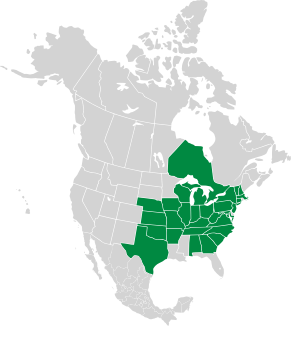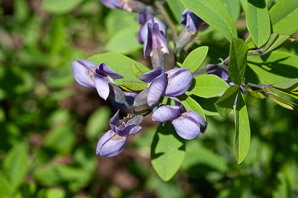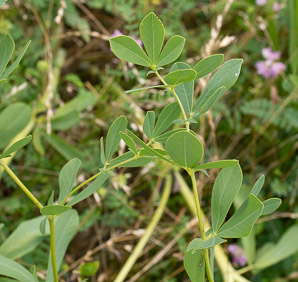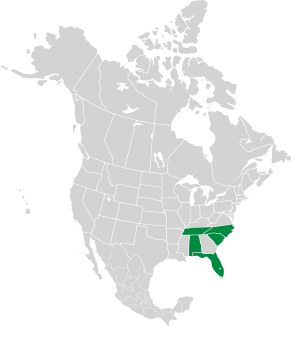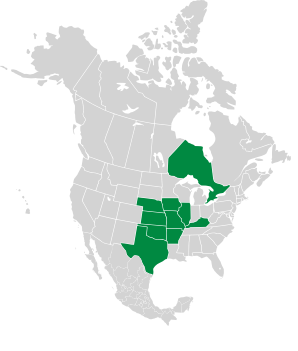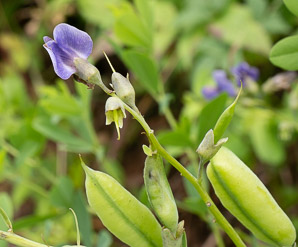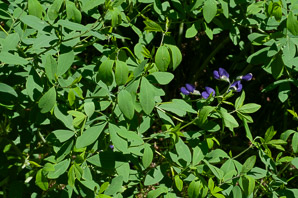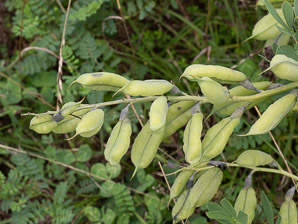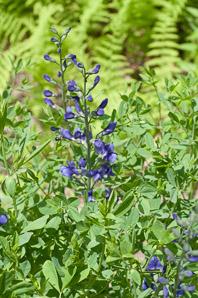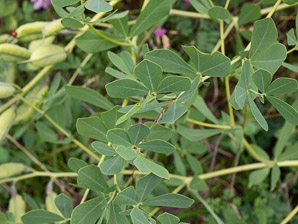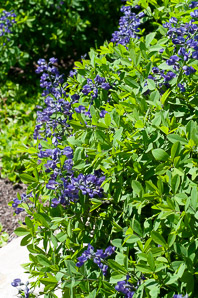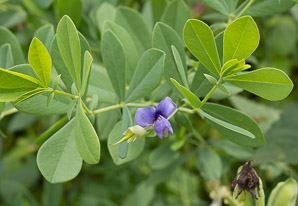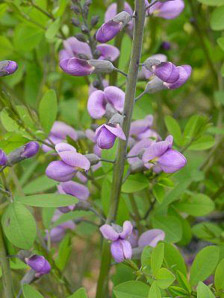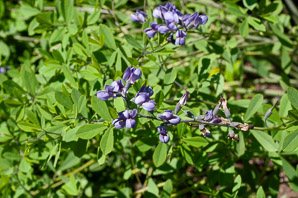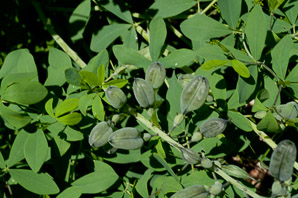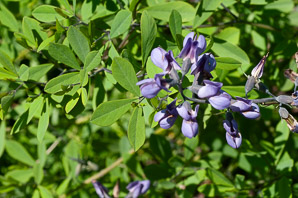
|
Baptisia australis (L.) R. Br. Blue false indigo, false indigo, blue wild indigo
Blue false indigo is native to North America. Baptisia means "to immerse"—a reference to this plant's use for creating dye, and australis means southern (not Australian), though I cannot find out what is southern about this species. Both the Cherokees and European settlers used the plant as a dye. This is called "false indigo" because it was used as an inferior substitute for Indigofera tinctoria. Compared below are varieties of blue false indigo, along with real indigo, which looks very different. |
6/17/2012 · Coastal Maine Botanical Gardens, Boothbay, Maine · ≈ 7 × 4½″ (17 × 11 cm) 7/3/2023 · Gettysburg National Military Park, Gettysburg, Pennsylvania |
||||||||||||||||||||||||||||
|
| |||||||||||||||||||||||||||||
Indigofera tinctoria |
You are here Baptisia australis |
Baptisia australis var. minor |
|||||||||||||||||||||||||||
|---|---|---|---|---|---|---|---|---|---|---|---|---|---|---|---|---|---|---|---|---|---|---|---|---|---|---|---|---|---|
| Common Name |  |
 |
 |
||||||||||||||||||||||||||
| Plant | Shrub, to 6′ (1.8 m) high. | 3-5′ (1-1.5 m) high, about 1½-3′ (50-99 cm) around. | 1½-2′ (45-60 cm) high. | ||||||||||||||||||||||||||
| Flowers | Pink/violet flower clusters, each flower ½″ (1.3 cm). | Light blue to dark purple. | Lavendar-blue. | ||||||||||||||||||||||||||
| Leaves | Pairs of opposite, rounded leaves on thin, vinelike branches. Leaflets about ¾″ (1.9 cm) long. | 1-1½″ (2.5-3.8 cm) long, green, bluish green, or grayish green, in groups of 3. | Bluish-green, in groups of 3. | ||||||||||||||||||||||||||
| Fruit | Clusters of bean pods, each 2″ (5 cm) long. | ⅞-3″ (2.5-7.5 cm) × ⅜-⅞″ (1.2-2.5 cm), bluish-black. | ¾-1¾″ (2-5 cm) long, brownish-black. | ||||||||||||||||||||||||||
| Range/ Zones |
|
|
|
||||||||||||||||||||||||||
| Habitats | Rich woods, thickets, meadows, stream banks | ||||||||||||||||||||||||||||
| Type | Wild | Wild | Wild | ||||||||||||||||||||||||||
Identification: Plants are 3-5′ (1-1.5 m) high, and about 1½-3′ (50-100 cm) around. When broken, the hairless stems secrete a fluid that turns dark purple on contact with air. (It is this reaction, not the flowers, that resulted in its use for dye.) Leaves occur in groups of three, each about 1-1½″ (2.5-3.8 cm) long, and may be green, bluish green, or grayish green. It's pea-like flowers, appearing at or in a spike near the top, vary in color from light blue to dark purple. Fruits are bluish-black hard pods ⅞-3″ (2.5-7.5 cm) long × ⅜-⅞″ (1.3-2.5 cm) wide. Seeds rattling in the dried seedpods have tricked more than one person into thinking a rattlesnake is nearby.
Medical: Blue false indigo has been used to treat a wide range of ailments, described at Wikipedia and pfaf.org. A tea from the roots served as emetic and purgative. In poultices or in the mouth, it served as an anti-inflammatory. Many other uses have been documented as well.
Online References:
The Lady Bird Johnson Wildflower Center
Plants for a Future, a resource and information centre for edible and otherwise useful plants
Kansas Wildflowers and Grasses
7/3/2023 · Gettysburg National Military Park, Gettysburg, Pennsylvania 
6/15/2010 · Garden in the Woods, Framingham, Massachusetts · ≈ 15 × 10″ (39 × 26 cm) 
7/3/2023 · Gettysburg National Military Park, Gettysburg, Pennsylvania 
5/22/2010 · Garden in the Woods, Framingham, Massachusetts · ≈ 12 × 18″ (30 × 45 cm) 
7/3/2023 · Gettysburg National Military Park, Gettysburg, Pennsylvania 
Baptisia australis description by Thomas H. Kent, last updated 11 Jul 2023.
© FloraFinder.org. All rights reserved.
6/17/2012 · Coastal Maine Botanical Gardens, Boothbay, Maine · ≈ 1 × 2′ (41 × 62 cm) 
7/3/2023 · Gettysburg National Military Park, Gettysburg, Pennsylvania 
10/17/2023 · By Jacquelyn Boyt 
6/17/2012 · Coastal Maine Botanical Gardens, Boothbay, Maine · ≈ 12 × 8″ (31 × 20 cm) ![]() ID is uncertain
ID is uncertain 
6/15/2010 · Garden in the Woods, Framingham, Massachusetts · ≈ 11 × 7″ (27 × 18 cm) 
6/17/2012 · Coastal Maine Botanical Gardens, Boothbay, Maine · ≈ 9 × 6″ (23 × 15 cm) ![]() ID is uncertain
ID is uncertain 
Range: Zones 3-8:
